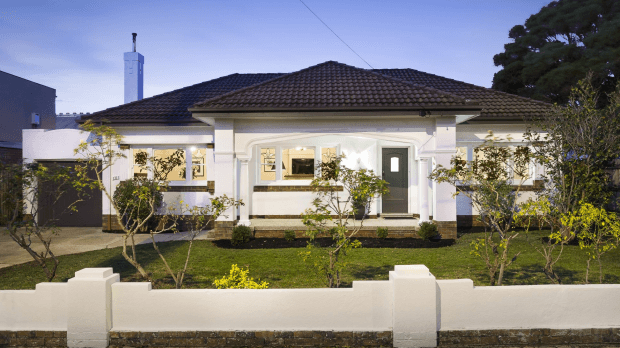Local agency Gary Peer, celebrating 30 years of selling property across the south-east from offices in Caulfield North and St Kilda, recognised a market shift. Unsuccessful homebuyers in Caulfield, Elsternwick, St Kilda East and Malvern East were looking next suburb out, a phenomenon that has swept across greater Melbourne as inner-suburban prices have sizzled.
In response, Gary Peer opened a third office in Carnegie about a year ago. “We found a lot of buyers missing out where we we’ve been specialising for years moving across to Carnegie and Murrumbeena,” says Leor Samuel, director of Gary Peer’s Carnegie branch. “It’s why we opened, to handle the next influx.”
Making up the wave of buyers are those who prefer bigger blocks, townhouses and single-level villa units over apartments in more built-up areas, such as St Kilda and Elwood or house-and-land packages further out. Investors, too, are jumping into Carnegie to take advantage of the capital appreciation.
But the attraction of Carnegie, somewhat under-appreciated over the years, goes beyond its relative affordability. It’s well appointed with amenities people want in a suburb: public transport; major arterials in and out of Melbourne; family-friendly parks and community facilities.
Carnegie also is culturally diverse, best reflected in the range of cuisines – from Greek and Italian to Thai and Korean – along the vibrant Koornang Road retail strip. A cafe culture similar to St Kilda East or Elsternwick is also burgeoning. “You’re buying into the same living,” says Woodards agent Benjamin Dax, who believes it works here because people are sociable and like to walk places.
As well, its housing has become sought-after – solid constructions, like art deco, built in the early decades of last century, which grew out of Rosstown, the area’s original residential estate, named after entrepreneur William Ross, who built a railway line that was never used for a sugar-beet processing mill that never operated.
Interestingly, it’s another contentious railway project – level crossing removal elevating sections of the Cranbourne-Pakenham Line, which cuts through Carnegie – aiming to improve movement and facilities in the area.
Locals love
- Koornang Road, the lifeblood of Carnegie, for its choice of restaurants and cafes, spanning a broad cross-section of ethnicities, as well as specialty stores catering for hair and beauty, gifts, homewares, travel and books. There’s also a budding cafe culture, with places such as Left Field.
- Its access along Dandenong Road or Monash Freeway into the city (or out of Melbourne) and public transport options (trains, buses and trams).
- Its parks, not just for the greenery but the family-friendly facilities offered: Koornang Park has a swim centre as well as golf practice cages and all-abilities playground, both of which can be found in Packer Park, which also has a velodrome, lawn bowls, bocce and wetland. Mallanbool Reserve has an indigenous and botanical trail.
- Its community facilities, including a children’s centre and toy library, Carnegie Library and Community Centre. It’s said that Rosstown changed its name to Carnegie in 1909 in an unsuccessful attempt to have industrialist Andrew Carnegie bankroll a library.
Where else to look: In and around Caulfield is worth a look, although it may mean stretching budgets. Pockets of Glen Huntly and Murrumbeena (median house price to June 2016 of $1,141,000), the next suburb out to the east, which is likely to be a little more affordable than Carnegie, offer a similar lifestyle. Depending on budget, you may widen your focus to include Hughesdale.
Three of the best In Carnegie
$1.15-$1.27 million
3 bedrooms, 2 bathrooms, 1 car space
The Edwardian-Federation style of architecture cuts a distinctive figure nestled among a lot of the area’s later-period housing (and some of its more recent). Behind the preserved facade – with its fretwork and leadlighting – is a sympathetic renovation, completed about 10 years ago, opening up the house and introducing a clean, simple modern elegance to its period appeal. What adds to its attraction is its proximity to most places – just minutes walk to Koornang Road, Carnegie Station, library, Glen Huntly Primary School and Koornang Park.
Room for improvement: It depends on the balance you want between modern and period. The renovated bathroom, for instance, has a heritage charm that may not be to everyone’s taste.
$1.5 million-plus
3 bedrooms, 1 bathroom, 1 car space
The period home – a bungalow built in the 1920s still with its original charm – is likely to appeal to buyers. The location of the property also is likely to prove attractive. Just off Koornang Road, the property is a couple of minutes on foot to parkland (Koornang Park and Lord Reserve) and public transport (buses to Elsternwick and Chadstone and trams to Melbourne University via the city). But it’s the size of the block that probably will pique most interest – 1017 square metres.
Room for improvement: This means there is plenty of space to substantially renovate and extend the existing house. Or you can bulldoze and start over if you want to build your dream house.
$950,000-plus
2 bedrooms, 1 bathroom, 1 car space
The great thing about inter-war houses, like this 1930s triple-front art deco, is their solid build. And this double-brick, apparently a one-time mayor’s residence at some point in its history, has held up well. They also have good volume, helped by high ceilings and well-proportioned rooms. While it has had cosmetic work, the place is ready to be reimagined – opened up and perhaps a two-storey extension added. What makes it worth it is the property’s walking distance to all of Carnegie’s best amenities: Carnegie Primary School, Koornang Road shops and Koornang Park. And there’s a tram on your doorstep.
Room for improvement: Of course, the corner-block property – given its position – may be bowled over, subject to council approval, and rebuilt, taking full advantage of the land.



